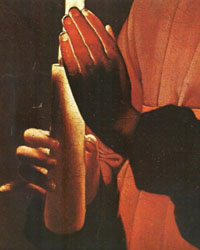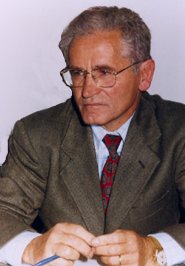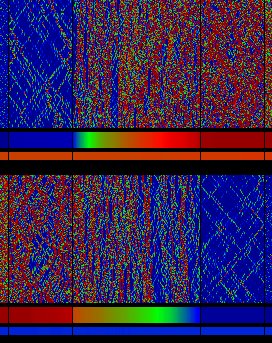It is a relatively easy to control the direction of an electric current – use a rectifier – but heat usually flows from hot to cold. Now, Italian and French researchers have devised a rectifier for heat in a computer simulation. They reckon a heat rectifier might be made from DNA or another biological molecule.
Giulio Casati, Michael Peyrard and Marcello Terraneo of Insubria University in Como, Italy, have simulated the vibrations of atoms in a crystal lattice and reckon that given the right arrangement of atoms a device could be built that carried heat energy in one direction only. They looked at one-dimensional solids whose vibrational frequency depends on the size of the vibration. A material such as a long strand of DNA in the solid state might behave in this way for instance.

Thermal transfer Renaissance style (Georges de La Tour, particular of Saint Joseph, Paris, Musée du Louvre)
In such an anharmonic material, energy is transferred less efficiently from one end to the other than in a harmonic material where the vibrational frequency (temperature) is independent of the amplitude of the vibration.
At its simplest level, thermodynamics describes atoms in a solid as vibrating with heat energy flow as though they are connected to each other by springs. Casati believes that computational tools can provide a deeper insight and as such allow interesting and potentially surprising properties, such as allowing heat to travel in only one direction.

Giulio Casati
A thermal rectifier might consist of an anharmonic chain molecule tethered by a stiff molecular spring at one end and a loose spring at the other. When the spring is at a higher temperature, the chain molecule will vibrate more slowly because energy is not carried through the chain so effectively. Imagine the effect of plucking a guitar string on to which small pieces of children’s play clay have been stuck. The sound produced would be muffled because of the inefficiency of the string’s vibration. Suppose such a thermal rectifier material as we describe is constructed and you put some object inside this material, then if what is inside is cold then it remains cold; if instead it is warm it will cool down. The heat can flow only in one direction, Casati explained to Spotlight.

Computer simulated rectifier
Such a thermal rectifier might have applications in electronics – as a cooling device for computer chips and in biotechnology as a heat flow controller for microscale chemical reactors. As to applications, I feel it is too early to say… much work needs to be done, confesses Casati, but what is important is that we now know that possibility exists.
Further reading
Phys. Rev. Lett. 88, 094302
http://link.aps.org/abstract/PRL/v88/e094302/
DOI: 10.1103/PhysRevLett.88.094302
Michael Peyrard
http://perso.ens-lyon.fr/michel.peyrard/
Suggested searches
Thermal Rectifiers
Thermodynamics